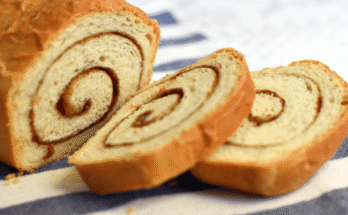Coconut Ice Cream Recipe: There’s something magical about homemade ice cream—it feels personal, indulgent, and always tastes better than store-bought. Among all the varieties, coconut ice cream stands out as a tropical favorite. Creamy, rich, and refreshing, it’s the kind of dessert that makes you feel like you’re on a beach vacation with every bite. The flavor of coconut blends beautifully with sweet creaminess, creating a frozen delight that’s both comforting and exotic.
Coconut ice cream has become increasingly popular not only because of its taste but also because it caters to different dietary lifestyles. Many versions can be made dairy-free, vegan, or even keto-friendly, depending on the ingredients you choose. It’s versatile, customizable, and perfect for anyone who loves the nutty, sweet notes of coconut.
Why Coconut Ice Cream is Loved Worldwide
Coconut has a naturally sweet and creamy flavor profile that pairs well with desserts. Unlike some fruits or flavors that require heavy sweeteners, coconut is naturally rich, making it ideal for ice cream. Its versatility is another reason—it can be combined with chocolate, mango, pineapple, or even nuts for endless variations.
Coconut ice cream is also popular in tropical countries like Thailand, the Philippines, and India, where coconuts are abundant. Street vendors often serve it in coconut shells with toppings like roasted peanuts or sweet sticky rice, turning it into a cultural dessert experience.
Health Benefits of Coconut in Ice Cream
Aside from taste, coconut offers surprising health benefits. Coconut milk contains healthy fats (medium-chain triglycerides) that provide quick energy and may boost metabolism. It’s naturally lactose-free, making coconut ice cream a great option for people who are lactose-intolerant.
Coconuts are also rich in electrolytes like potassium, which help keep you hydrated. Of course, ice cream should be enjoyed in moderation, but when made with natural ingredients, it’s a treat you can feel good about.
Ingredients You’ll Need
Before diving into the recipe, let’s get our ingredients and tools ready. A good ice cream recipe always starts with the right base.
Main Ingredients for Coconut Ice Cream
To make a classic coconut ice cream, you’ll need:
- Coconut milk or coconut cream – the star ingredient that gives creaminess.
- Heavy cream or whipped cream (optional for extra richness if not making vegan).
- Sugar – for sweetness (can substitute with honey, maple syrup, or stevia).
- Egg yolks – for a custard-like texture (optional, but recommended for creaminess).
- Salt – just a pinch to balance the flavors.
Optional Ingredients for Extra Flavor
Want to make your coconut ice cream extra special? Add:
- Vanilla extract – enhances sweetness.
- Shredded coconut – for texture.
- Chocolate chips or cocoa powder – for a twist.
- Fresh fruits like mango, pineapple, or berries.
- Nuts such as almonds or cashews for crunch.
Tools and Equipment Required
- Ice cream maker (optional but recommended).
- Mixing bowls.
- Whisk or electric mixer.
- Saucepan.
- Spatula.
- Airtight freezer-safe container.
Preparing for the Recipe
Before you start mixing, it’s essential to prepare properly so your ice cream turns out smooth and creamy.
Tips Before You Start Making Coconut Ice Cream
- Chill your coconut milk or cream in the refrigerator for at least 2 hours. This helps separate the thick cream from the watery part.
- Place your mixing bowl and whisk in the freezer for 10 minutes before whipping. Cold equipment helps create a better texture.
- If you’re using an ice cream maker, make sure the bowl is frozen for at least 12 hours beforehand.
Choosing the Right Coconut Milk or Cream
Not all coconut milk brands are the same. For the creamiest results, use full-fat coconut milk or coconut cream. Light or reduced-fat versions will make your ice cream icy instead of creamy. If possible, go for unsweetened coconut milk so you can control the sugar levels.
Importance of Fresh Ingredients
Freshness makes a huge difference. If using shredded coconut, toast it lightly to bring out its nutty flavor. Fresh vanilla beans instead of extract can also make the ice cream more aromatic. Using fresh fruit toppings rather than canned ensures natural sweetness and less added sugar.
Step-by-Step Guide to Making Coconut Ice Cream
Now comes the fun part—actually making the ice cream! Follow this step-by-step process for the best results.
Step 1 – Preparing the Coconut Base
In a saucepan, combine coconut milk, heavy cream, and sugar over medium heat. Stir until the sugar completely dissolves. If you’re using egg yolks for custard-style ice cream, whisk them in a separate bowl and slowly temper with the warm coconut mixture before combining. This prevents curdling and ensures a silky texture.
Step 2 – Mixing and Sweetening the Base
Once the mixture is smooth, add in vanilla extract and a pinch of salt. If you want a stronger coconut flavor, stir in some toasted shredded coconut. Taste the mixture at this stage and adjust sweetness if necessary.
Step 3 – Chilling the Mixture Properly
Transfer the base into a bowl, cover it, and refrigerate for at least 4 hours or overnight. The longer you chill it, the better the flavors develop, and the creamier your ice cream will be.
Step 4 – Churning the Ice Cream
Pour the chilled mixture into your ice cream maker and churn according to the manufacturer’s instructions (usually 20–30 minutes). If you don’t have an ice cream maker, you can place the mixture in the freezer and stir every 30 minutes for 3–4 hours to prevent ice crystals.
Step 5 – Freezing to Perfection
Once churned, transfer the ice cream to a freezer-safe container. Smooth the top with a spatula, cover with plastic wrap or an airtight lid, and freeze for another 3–4 hours until firm. When ready to serve, let it sit at room temperature for a few minutes before scooping.
Variations of Coconut Ice Cream
Coconut ice cream is delicious on its own, but part of its charm is how easily it can be customized. Whether you want a healthier option, a more indulgent treat, or a fruity twist, there’s a variation for everyone. Let’s look at some popular styles you can try at home.
Vegan Coconut Ice Cream
If you’re dairy-free or vegan, you can still enjoy a creamy bowl of coconut ice cream without compromising taste. Simply use full-fat coconut milk or coconut cream as your base and skip the dairy altogether. For sweetness, go for natural alternatives like maple syrup, agave nectar, or coconut sugar. You can even blend in soaked cashews for extra creaminess.
Instead of eggs, vegan recipes often use cornstarch or arrowroot powder to thicken the mixture. These starches give the ice cream a custard-like texture without animal products. To enhance the flavor, add a splash of vanilla extract, a drizzle of almond butter, or even a handful of toasted coconut flakes for crunch.
The best part? Vegan coconut ice cream is lighter yet still indulgent, making it perfect for those who want a guilt-free treat.
Coconut Ice Cream with Chocolate Chips
Love chocolate? Then this version is a must-try. Once your ice cream mixture has been churned and is semi-firm, fold in dark chocolate chips or chopped chocolate chunks. As the ice cream freezes, the chocolate hardens, giving every spoonful a delightful crunch.
For a richer twist, swirl in melted dark chocolate or even a ribbon of homemade fudge sauce. This combination of creamy coconut and bittersweet chocolate creates an irresistible balance of flavors.
Tropical Coconut Ice Cream with Fruits
Coconut pairs beautifully with tropical fruits. Add diced mangoes, pineapples, passionfruit, or bananas to your base for a fruity explosion. You can mix the fruit in during churning or layer it in before freezing for a ripple effect.
For a more exotic version, try blending the fruit directly into the base before freezing. Mango-coconut ice cream, for instance, is smooth, bright, and bursting with tropical flavor. Garnish with extra fruit chunks before serving for that Instagram-worthy presentation.
Serving Suggestions
Presentation can take your coconut ice cream from a simple treat to a gourmet dessert. Here’s how you can serve it in style.
Best Toppings for Coconut Ice Cream
- Toasted coconut flakes – enhance the coconut flavor with a nutty crunch.
- Caramel or chocolate drizzle – adds extra sweetness and richness.
- Fresh fruit slices – mango, pineapple, strawberries, or kiwi for a tropical vibe.
- Crushed cookies or graham crackers – for a crunchy texture.
- Chopped nuts – almonds, cashews, or pecans complement the creaminess.
Pairing with Desserts and Drinks
- Serve a scoop on top of warm brownies or apple pie for a hot-and-cold contrast.
- Pair with sticky rice for a Thai-inspired dessert.
- Enjoy with iced coffee or iced tea for a refreshing afternoon treat.
- Create a sundae by layering with whipped cream, syrups, and cherries.
Coconut ice cream is so versatile that it fits well into any occasion—whether it’s a family gathering, a dinner party, or just a cozy night in.
Storage Tips
Homemade ice cream doesn’t contain preservatives, so proper storage is key to keeping it fresh and delicious.
How to Store Coconut Ice Cream for Freshness
- Store in an airtight, freezer-safe container to prevent ice crystals from forming.
- Place a sheet of plastic wrap directly on top of the ice cream before sealing to minimize freezer burn.
- Keep it in the coldest part of the freezer, away from the door where temperature fluctuates.
Shelf Life and Freezer Tips
- Homemade coconut ice cream usually lasts up to 2 weeks in the freezer.
- After that, it may develop ice crystals and lose creaminess.
- If the ice cream becomes too hard, let it sit at room temperature for 5–10 minutes before scooping.
By storing it correctly, you’ll always have a creamy scoop ready whenever those sweet cravings hit.
Common Mistakes to Avoid
Even though making coconut ice cream is simple, a few mistakes can ruin the texture or flavor. Here’s what to watch out for.
Over-Churning or Under-Chilling
If you churn the mixture for too long, it can become grainy instead of creamy. On the other hand, if you don’t chill the base long enough before freezing, it won’t thicken properly. Always chill the mixture for at least 4 hours before churning, and follow your ice cream maker’s instructions carefully.
Using the Wrong Type of Coconut Milk
Choosing the wrong coconut milk is one of the biggest mistakes beginners make. Light or low-fat coconut milk will result in icy, watery ice cream. For the best results, always use full-fat coconut milk or coconut cream. The fat content is what gives the ice cream its smooth, creamy texture.
By avoiding these pitfalls, you’ll always end up with a batch of ice cream that’s rich, flavorful, and perfectly scoopable.
Nutritional Value of Coconut Ice Cream
Coconut ice cream isn’t just tasty—it also comes with a unique nutritional profile that makes it stand out from traditional dairy ice creams. While it’s still a dessert and should be eaten in moderation, the coconut base brings certain health benefits.
Calories and Macronutrients
A typical serving (about ½ cup) of homemade coconut ice cream contains:
- Calories: Around 200–250 (depending on added sugar and cream)
- Fat: 15–20g (mostly from coconut milk/cream)
- Carbohydrates: 15–20g
- Protein: 2–4g
The high fat content comes from medium-chain triglycerides (MCTs) in coconut, which are easier for the body to digest compared to long-chain fats. These MCTs provide a quick energy boost rather than being stored as fat.
Healthier Alternatives
If you’re aiming for a lighter version, you can:
- Replace regular sugar with stevia, monk fruit, or erythritol to cut calories.
- Use a mix of almond milk and coconut cream for fewer calories but still creamy results.
- Add chia seeds or flax seeds for extra fiber.
- Blend in fruits like mango or banana to naturally sweeten the ice cream without refined sugar.
This way, you can turn your coconut ice cream into a treat that’s both indulgent and nourishing.
FAQs about Coconut Ice Cream Recipe
1. Can I make coconut ice cream without an ice cream maker?
Yes! Simply freeze the mixture in a container and stir every 30 minutes for about 3–4 hours to break up ice crystals. This manual method creates a creamy texture without needing a machine.
2. How long does homemade coconut ice cream last?
If stored properly in an airtight container, it lasts up to 2 weeks in the freezer. After that, it may lose creaminess and develop ice crystals.
3. Can I replace sugar with honey or maple syrup?
Absolutely. Both honey and maple syrup work well as natural sweeteners. Just remember that honey will add floral notes, while maple syrup gives a caramel-like depth.
4. What’s the best coconut milk for ice cream?
Always choose full-fat, unsweetened coconut milk or coconut cream. Light versions won’t give you the same richness and may make the ice cream icy.
5. Can I add nuts or fruits to the mixture?
Yes! Chopped nuts, fresh fruits, or even dried fruit pieces can be mixed in during the churning process or layered before freezing for extra texture and flavor.
Conclusion
Making coconut ice cream at home is easier than most people think. With just a handful of ingredients and a little patience, you can create a tropical dessert that’s creamy, flavorful, and completely customizable. From classic versions to vegan alternatives, chocolate swirls, and fruity variations, the possibilities are endless.
Whether you enjoy it in a bowl topped with toasted coconut flakes, sandwiched between cookies, or served alongside a warm dessert, this homemade treat never disappoints. Plus, by controlling the ingredients, you can make a healthier, preservative-free version that fits your lifestyle.
So, the next time you crave something sweet, skip the store-bought tubs and whip up your own coconut ice cream—you’ll taste the difference with every scoop.



